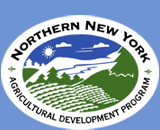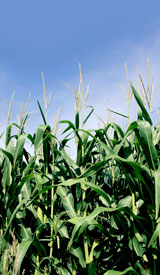April 14, 2008
Contact: Gary C. Bergstrom, Cornell University, 607-255-7849, Michael
Wunsch, cell: 607-351-4234; or NNY Cornell Cooperative Extension offices
Note: Michael Wunsch will be checking alfalfa variety plots and sampling
forage grass fields in NNY sometime late April to mid-May, depending on
weather and field availability � call Michael at 607-351-4234 or Kara
Dunn at 315-465-7578 to schedule field interviews.
Cornell Researchers Urge Farmers to Look Now for Brown Root Rot:
Photo Resource Online at www.nnyagdev.org
Now is the time to scout fields for brown root rot say Cornell
University researchers. With a grant from the Northern New York
Agricultural Development Program, a team of Cornell faculty and
Extension educators are helping regional farmers recognize the disease
in alfalfa and forage grass crops.
Cornell Plant Pathology Professor Gary C. Bergstrom says, �April through
early May is the best time to assess over-wintered alfalfa plants for
the symptoms of brown root rot.�
Brown root rot, caused by the fungus Phoma sclerotiodes, is a
cold-weather disease affecting the roots and crowns of alfalfa during
the dormant period when plants are not actively growing. To help farmers
recognized brown root rot damage, an online resource in the Field Crops:
Alfalfa section at www.nnyagdev.org
(or
click here) includes photographs of the disease confirmed in
Northern New York in 2003.
Bergstrom says, �Characteristic lesions can be seen on the roots and
crown of plants showing slow regrowth of shoots from the crown buds in
spring.�
To assess crops farmer need only a shovel or trowel, a bucket of water
and a pocket knife for digging up, cleaning and slicing the roots of the
alfalfa to determine if the plant has lesions and how deep they run. The
lesions are usually light to dark brown with a darker edge. The severity
of brown root rot increases as plants age and experience more winters.
Absolute confirmation of the disease requires a molecular laboratory
test that is now available from the Cornell University Plant Disease
Diagnostic Clinic. A composite field sample costs $40.
Clinton County in Northern New York was the first county in the state to
be confirmed to have brown root rot in 2003. High incidence levels of
the disease have since been seen in alfalfa fields across NNY and in
Western New York and the Southern Tier of the estate.
Cornell Plant Pathology graduate student Michael Wunsch says, �Spatial
patterns within the tested fields (8 of 10 fields in NY, 6 of 7 fields
in Vermont, and 5 of 6 fields in New Hampshire tested positive for BRR)
suggest the pathogen was not recently introduced in the Northeast.�
Brown root rot has been in Western Canada and Northwestern U.S. crops
for decades. It was first observed in the lower 48 states in Wyoming in
1996. In eastern North America, prior to the recent Cornell field
surveys in New York, it had been reported in only Nova Scotia.
With funding from the Northern New York Agricultural Development
Program, Bergstrom and a research team from Cornell that includes Wunsch,
Everett Thomas at the William H. Miner Agricultural Research Institute,
Michael Davis at the Cornell E. V. Baker Agricultural Research Farm, and
Brett and Jay and Lew Dickson of Dickson and Sons, Inc., Bath, NY, are
conducting alfalfa variety trials in regional soils infested with brown
root rot in order to identify varieties that may be more
disease-resistant.
Fields with 11 varieties of alfalfa at the W. H. Miner Agricultural
Research Institute in Chazy, NY, and at the Cornell E.V. Baker
Agricultural Research Farm in Willsboro were inoculated with Phoma
sclerotiodes in spring 2006 and spring 2007. This spring 125 plants of
each of the varieties will be collected and assessed for brown root rot
at Cornell laboratories. Six species of forage grasses planted at both
farms will be similarly evaluated. A field survey of forage production
fields is also underway in each of the six NNY counties: Jefferson,
Lewis, St. Lawrence, Franklin, Clinton and Essex.
Farmers from across the region lead the Northern New York Agricultural
Development Program which funds regional on-farm research, education and
outreach for the agricultural industry. To learn more, go online to
www.nnyagdev.org. Farmers can
contact their local Cornell Cooperative Extension office for more
information on brown root rot. # # #



